Welcome to Garden bloggers Foliage Day where I ask you to share all or some of the foliage that you are enjoying in your garden this month. Today I’m going to show you what the plants in my garden look like after two months of drought and temperatures that haven’t dropped before the mid 30’s C during the day and not below 25°C at night. Many of the plants I’m going to show you haven’t had any irrigation in that time, others have had to have some water just to keep them alive. But this isn’t a depressing post (well, I hope it isn’t) while taking the photographs I gained some insights into how the garden is and my view of it.
Firstly some long views that really shows that a Mediterranean garden is ALL about foliage in mid-summer. I can enjoy flowers in spring and before the heat arrives and it is worth planting some specific areas of the garden to make the most of the short season of colour. But high summer is about foliage and to a large extent evergreen foliage as those are the plants that generally have the tougher leaves that than can curl in on themselves to expose less of the leaf to the sun. All images were taken at 5 pm on Tuesday 21st July
When I walked out of the door to take the photographs I thought I was going to hate everything I saw but actually I realised that there is a harsh beauty in the forms and textures of the garden.
Even the Cistus (left) is showing more brown than green and that is a true native to this area, but that doesn’t mean that it looks beautiful when it is protecting itself from the drought and burning sun.
These Verbena bonariensis are flowering (with colour) because they are right next to the new Cypresses that are being given large amounts of water once a week while they establish.
The thyme in the foreground isn’t its usual beautiful green, but it will recover.
Melia azedarach, Arbutus, Quercus ilex all cope well with the heat.
The tree at the end of this view is a walnut; last year I was very scathing about the walnuts, saying I would like to remove them, but both are dealing well with the heat so they have earned their right to stay in the garden.
The roses in the circular rose bed are getting regular water.
Stipa gigantia is well past its best but still gives some interesting movement to the scene.

Looking west across the front of the terrace, strong shadows and bright light make the lavender look colourless
White Agapanthus in a large pot do add some light to the view, last year they didn’t flower at all, I think because they lacked water the previous year so I must ensure that they have enough water this year.
I want this post to be a true representation of how the garden looks today so let’s have a closer look at some of the foliage, not only showing what’s good. I am almost happy that the weather is so hot because I am planning the redesign of the formal beds and I am much more aware that the design needs to be functional during med summer when we sit on the terrace and have meals there too. But more about my thoughts on that later in the week.
Elaeagnus foliage almost looks as if it has been burnt in a fire.
Notice how the leaves turn in on themselves to create a smaller surface area. The Phlomis would look better it I had removed the flowers when they had finished; sliver is better than brown!
In June you couldn’t see the stems of this cistus but with dropping and curling of its foliage all the stems are visible.
Again with the Viburnum burkwoodii the foliage is curled in on itself in an attempt to reduce transpiration.
I’m sure the Cerastium will come back but it looks dreadful at present.
Sorry this has been much longer than my usual posts. I am convinced that with the correct choice of plants the garden can look better but I’m equally sure that it is also a question of my eyes appreciating a different kind of garden, one where, in summer, foliage really is the most important feature and that considering form and texture is what almost all gardening is all about.
I do hope you’ll join in with GBFD and share some of your foliage or even analyse what foliage does in YOUR garden, just link to this post and leave a comment with your link.
To end some foliage that thrives in the heat and sun.
HAPPY SUMMER!
Christina

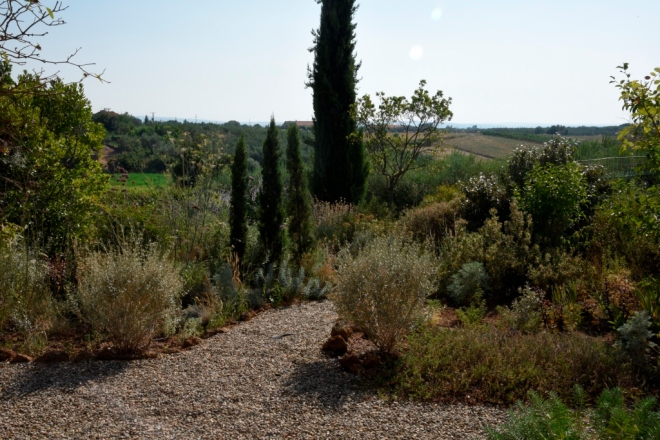

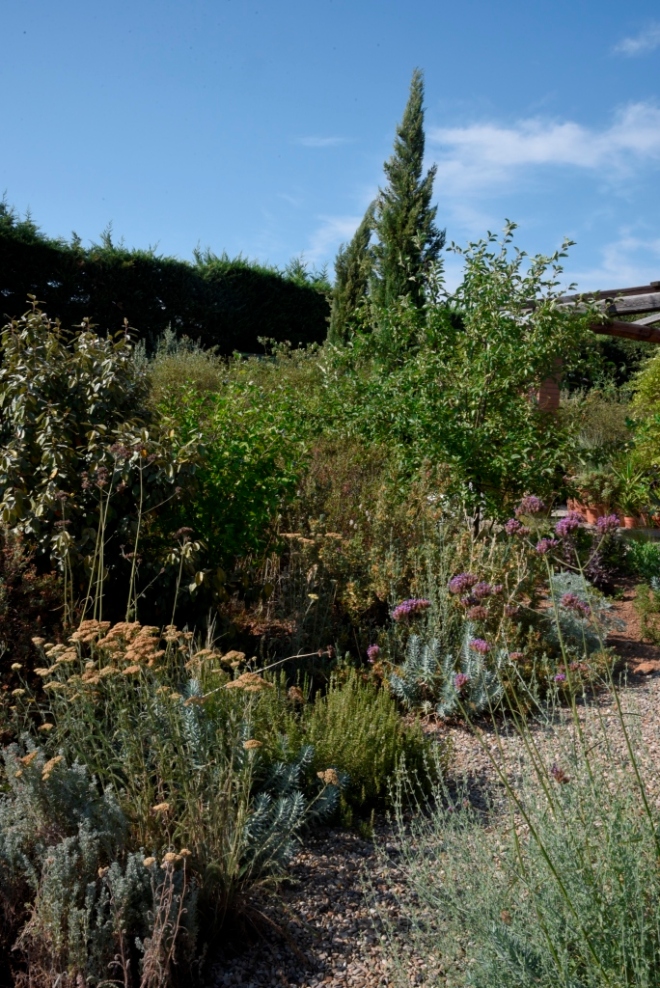
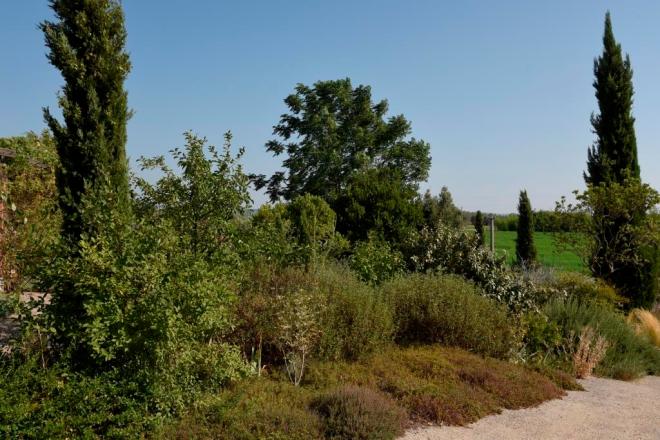

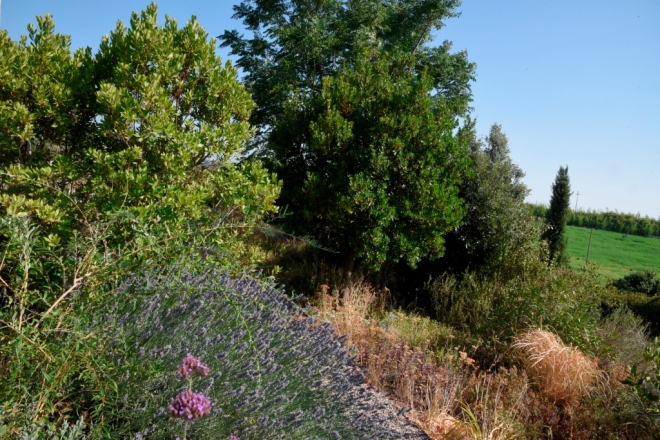


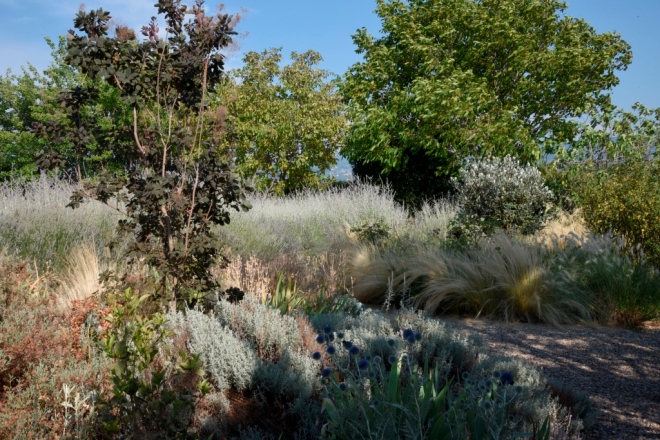

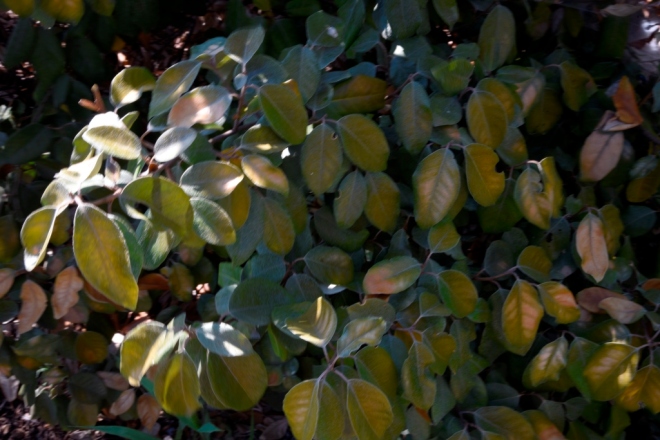
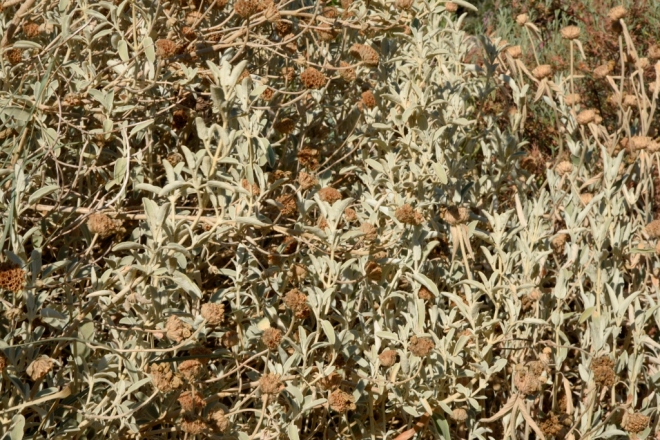







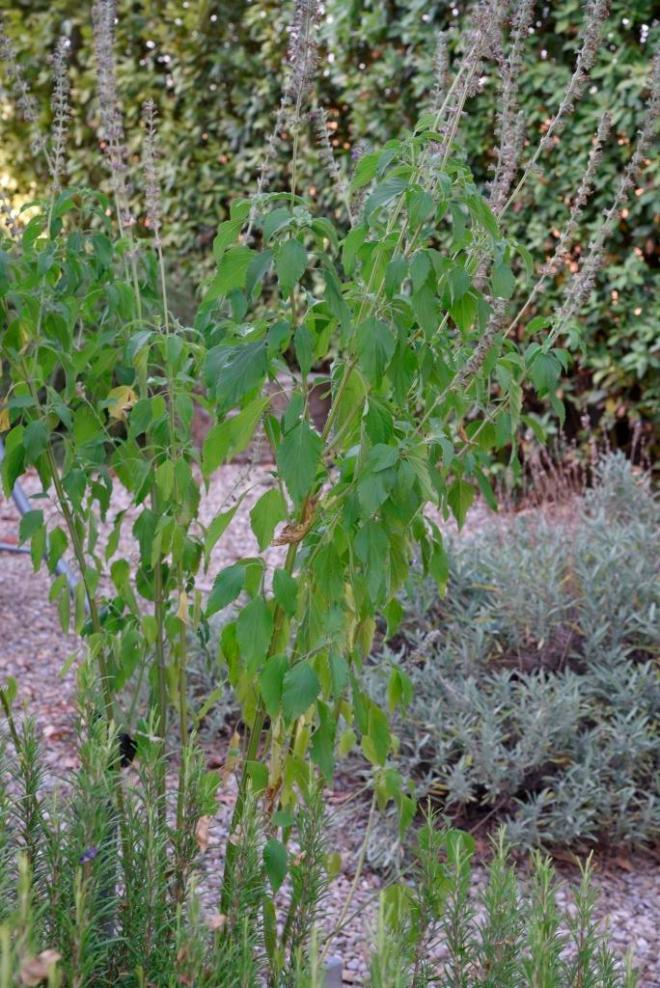



This is a wonderfully informative post, Christina and a real tribute to what can be achieved in the sun at such high temperatures. I’ve learnt such a lot from it. Amelia
Thank you Amelia, I learnt a lot from looking but also because I was away so much of June I didn’t see the transition just the drastic change.
Pingback: GBFD July – Any Port in a (Winter) Storm | Railway Parade House and Garden
This is quintessential gardening, and a great post!
I lived in Adelaide back in the 1980s and it reminds me of the trials of gardening there (also a Mediterranean climate).
Similar, exhausting heat that drags on for weeks and the lack of any meaningful rain in summer. Plants and gardeners have to be tough!
The things that stand out the most are the conifers and grass like plants: they are thriving (and not just those getting water).
Funnily enough, here, on the other side of the world battered by terribly cold weather, they are the only things that are looking good in my garden as well. They really do cope with extremes!
My contribution is here: https://railwayparade.wordpress.com/2015/07/22/gbfd-july-any-port-in-a-winter-storm/
I’m so glad that you thought my post meaningful. I don’t often have time to write about everything I’m thinking about but maybe I should try to find some time at least once a month. I like your observation about the conifers, I hadn’t really thought about them in that way, maybe I need more in my garden. I’d love to send you some of our heat to warm you a little but maybe some cold is good for the garden.
Christina I’m in awe of your resilience (and of course the resilience of the plants). Is this the cycle every year-drought and near collapse of most of your garden -followed by a steady recovery by next Spring? That’s serious dedication and huge effort on your part. But I love the look of even the scorched planting -there’s beauty in decay especially when it highlights texture and form. I guess you value the recovered plants (when you see signs of life) more than ever-I know I would.
This year the high temperatures and drought began earlier than usual, by about 2 to 3 weeks. there hasn’t been any serious rain since mid-May and none at all since the beginning of June. Last year I was spoilt as it rained a lot during summer (not by English standards I hasten to add) and the temperatures were lower so the garden looked great all summer. But 2 months of drought is normal, I live with it and try to do what I can and I’m learning to love a different look from the lush green of England. There have been times when returning to England I’ve looked out of the plane window and the green has hurt my eyes.
I think the important thing is to see the beauty where you live and, obviously, you do. For a summer, I was in drought-ridden west Texas; at first it looked as if a bomb had gone off, but after a while my eye began to register the desolate beauty. Here, I don’t have summer flowers because of shade and while I still miss roses, salvias, and other summer bloomers, there is something serene and soothing about an all-green landscape. Plus, I have the consolation of knowing late winter and spring will be filled with flowers and fall will offer brilliant foliage color. Plants are amazing, aren’t they? You are such an astute gardener; I know your garden will just get better and better.
I appreciate your confidence Marian. Certainly I have learned so much about gardening in harmony with the climate and soil conditions. I don’t think English gardeners actually realise how lucky they are to be able to grow such an enormous range of plant species. While I was visiting the US I began to understand the role of humidity in allowing many plants to thrive even in quite extreme temperatures. I think the most important part of gardening is to make the most of the conditions and not try to fight them.
I really enjoyed the well written and detailed observation, it brings the story of images to life. Thank you for taking the time to write such an interesting post.
I agree with comments here regarding plants that look good when they’re not blooming or even in leaf. Here in the UK I appreciate this through the winter months, so it’s good to be reminded that hotter climes have a different off-peak to consider.
Thank you Kate, as I said to Matt I don’t often find the time to write a long post allowing the images to tell the story but everyone’s kind comments make me realise that I should try harder to write about the things I think are important.
I think there’s a case for both, it was just very interesting to have the foliage responses explained by someone who understands their plants and climate so well.
I guess the aroma must be quite distinctive, too?
Yes, the lavender and Perovskia both have perfumed foliage; my husband loves the smell of Cistus but I can’t smell anything. Actually it is the sound that tells me it is a hot Mediterranean garden. There are always lots of bees while the lavender and Perovskia are flowering but I know when it is really hot when I can hear the cicadas. They are starting earlier and earlier each day.
And there’s another evocative subject, a post in the making perhaps?
I think I have written about that in the past Kate. It is difficult when the blog is as old as mine to keep coming up with new interesting subjects when some of my followers have been here since the beginning. But then new readers often like to see how things developed so I do try to do some regular updates.
Thanks Christina, I’m new and will happily have a look through your archives.
I think your husband is right about cistus … It jogged my memory of a mass planting of them outside a pavilion in Kew Gardens on a (rare) hot summer’s day ….
You still have lots of colour, shape and texture from your foliage Christina, it is still beautiful but in a different way. I can remember reading that Beth Chatto almost weakened and watered her gravel garden when it was so hot and dry after she made it. Instead she cut everything back and once the rain came in September, all her plants sprouted again, hopefully yours will do the same.
my link is http://leadupthegardenpath.com
I remember reading that about Beth’s gravel garden, that is a major influence on my plant choices. Of course there is a huge difference between mid 20’s C and high 30’s C. I have had to water some plants but others will come back when it rains in September, but I hate seeing everything look so stressed. Thank you for joining in again this month, I’m looking forward to enjoying some beautiful foliage in your garden.
Wow that is quite a drought Christina. But still the garden foliage plays a lovely role in the beauty of your garden. It is a good thing most of it will bounce back once the drought breaks. Our desolate look is in winter and early spring.
I thought I would link in with a favorite foliage plant growing in my shade garden:
When I feel depressed about the heat I always try to think of you and how positive you are during the winter. I’m getting better at enjoying what I have.
Pingback: rusty duck - Starring Roles
Christina, you have brought home some reality to my dreams of living in a much warmer climate. It comes to something when even the rosemary is starting to die back. But, as you say, these plants are native and they are tough. They will bounce back.
Here is my link: http://www.rustyduck.net/2015/07/22/starring-roles/
I had at one time intended to call the post ‘Lush’. I’m glad I didn’t. I just wish we could share out our rain and clear blue skies equally. Enjoy your sunshine. I raided my winter wardrobe for fleeces last night!
I wouldn’t have minded if the post had been called “lush”! Yes, the reality of a hot climate is different from what we all imagine. Italy DOES weather as I’m fond of saying, when it rains it is torrential (Rome and London have the same annual rainfall but in Rome it falls all at once), the winds are gales hot and cold and the heat sapping. I do remember that even July days can be cold but “a fleece”! Here it is so hot that it is difficult to sleep, it usually cools down a little about 4 in the morning, 24°C is about the average night time temperature, I imagine that is hotter than your days at present.
Thanks for the survey…I think dormancy proves good garden design, summer or winter dormancy. And this summer is proof of your design ./ plant skills!
Your temperatures sounds hot – much like our’s, though we are much further south (31.75 deg N), a high 1165 meter elevation, an urban heat island, and now we’re getting humidity with monsoonal showers many days. Unless the Phlomis and rosemaries are many and in prominent places, they hardly detract from all else.
Only this Rosemary is suffering and it isn’t too unusual for plants to gave some die back. The temperatures aren’t unusual for mid to end of July but the temperatures were the same in June and that is unusual. As I discovered when I was in the States in June humidity really helps plants if not the people. We might start getting evening thunder storms which will at least cool things down at night.
Our gardens are poles apart right now and it’s been an education for me reading this post. Appreciating how plants cope with the conditions you have there Christina is one I don’t really need to consider much but this post has gone a long way to helping me understand why some plants ‘do what they do’ in order to survive.
Here’s my link.
http://mygardenblogs.blogspot.co.uk/2015/07/garden-blogger-foliage-day.html
Hi Angie, thank you for joining GBFD this month, I’m glad my post was helpful. I have learned so much living and gardening in another climate. I think because the climate in England is good for so many plants it is harder to understand how their needs differ. I have always been an advocate of right plant, right place but didn’t fully appreciate all the implications before.
Sorry Angie, I’ve only got my iPad with me at the moment and I couldn’t leave a comment on your post using it. Let me just say I love your lush garden and the plants look amazing.
Quante informazioni preziose e quante accurate osservazioni da parte tua! poi ci dirai di più quando ci vedremo!
A refreshingly honest post, Christina, despite temperatures that are far from refreshing! It was really interesting to hear how your different plants responded and know that you will take this on board for future planting – interesting too to read about the response of September rain in Beth Chatto’s garden. You can almost ‘see’ the heat in your pictures and the aromas must be so very different when it is that hot for days on end. I make a point of accepting the weather as it comes and I fully appreciate how fortunate we are with our temperate climate in the UK and how doubly fortunate I am with my central location within the UK! I didn’t post for GBFD last month and today is a WW one – but a useful exercise taking the photographs. Thanks for hosting.
Thanks for taking time and some great images of some truly beautiful foliage for GBFD.
Hi Christina! I admire your positive attitude in assessing your garden this month. The key textural forms are certainly carrying you through. So wise of you to have attended to developing that aspect of your garden, as you still have some great long views. You did a good job of illustrating how plants adapt to the extremes of heat and drought–their defenses kick in to help them survive as best they can. And then isn’t it interesting how some plants are still just fine. I don’t remember noticing your succulents on the terrace before. You have a large collection and they’re quite attractive grouped together. I like the white sphere too! As you know foliage is not my greatest strength but I always enjoy taking some time to consider which things are working. Here’s my contribution for July. https://pbmgarden.wordpress.com/2015/07/22/garden-bloggers-foliage-day-july-2015/
I planted up the succulents last autumn after reading Kris in L.A.’ posts
Sorry that wasn’t supposed to go then, I meant Kris in L.A’s posts. Most are semperivirrens so very tough and hardy, I bought some in the UK ages ago., others have been at plant swaps, I haven’t bought any. I’ll show them in more detail sometime. The white sphere is a light, it looks like the full moon when it’s alight. I want to add some others when I do the redesign. Thanks for joining in this month. Your post was up early, but I only have your link now.
Spheres seem to work well in the garden and one that lights up, even better. I finished my post just before having to rush off to yoga class. Didn’t have time to read yours and add my link until later. Thanks for hosting.
Everything is lush and green here in NW England so it’s very interesting for me to see how your garden fares in the fierce heat and drought of summer Christina. It’s amazing how your plants recover isn’t it? I’ve been propagating foliage plants for my own garden this month. http://countrygardenuk.com/2015/07/22/foliage-day/
It is hard to imagine that your summer has been so bad when your spring was actually better than it was here this year. Thanks for joining in this month, I’m interested to see what you have been propagating.
Great post, Christina!Thanks!
When I see photos of Piet Oudoulf’s wonderful plantings I always like the shots in autumn when it becomes more monochromatic. Guess I’m well positioned for the draught…except I really hate the heat. When you zero in on some of the more afflicted plants, they do look sad, but the overviews are lovely, as always. Just one simple vignette in my offering: http://bannersbyricki.com/archives/4796
I agree about Piet Oudoulf’s planting but they do rely on reasonable amounts of summer rain, it is telling that there are none of his gardens in the Mediterranean area. Thanks for joining GBFD and I enjoy your vignettes immensely each week.
I sympathize, Christina. Hot and dry conditions like that are miserable to deal with, especially when they overstay their welcome. Most gardens here are built with extensive irrigation systems because we rarely get any rain from May through October; however, as our use of those systems is now limited, I’ve been toting my stored rain water around in cans and buckets so I can imagine the extra hassles this period of dryness is causing you. I hope you get a break in the heat soon and a spot of rain. Your garden still looks very good to my eyes.
Your temperatures are higher than ours and for longer but you don’t have cold winters so there is a different range of plants available to you that will tolerate the heat and drought. Our winter temperatures can be as low as minus 10°C. I do have an irrigation system and we have a well which provides all of our water but I don’t think it is appropriate to use huge quantities of water for ornamental plants, I make the exception for the vegetable beds and the cuttings beds (which I know are an indulgence but at least they are concentrated together.
Two months of drought still tops shoveling any snow, doesn’t it?
I think the beauty of your garden is still obvious and even with some dry and hot weather your selections of plants and care in siting are really paying off. I’m actually a bit surprised everything looks as lush as it does!
I did try to make a small contribution this month. Much lusher and more flowery than yours for sure! https://katob427.wordpress.com/2015/07/22/gbfd-summer-sunshine/
Yes, you’re right I wouldn’t like the garden to be covered in snow all winter like yours; but the plants would be less stressed, I probably couldn’t live in your humidity either so I will just have to make the best of this dry heat. Thanks for joining this month Frank.
Dear Christina, I admire your honesty in showing the truth of your plants in this post; even those which aren’t very pretty at present. I hope they are resilient and all survive. Your good design shows through in the silhouettes, even though some foliage is browned and scorched. The lavender looks happy! And many other plants look happy, too. I hope you get a little rain at a time as the garden rehydrates, now that we are past mid-summer. I love your foliage meme, and it is a nice way to document what is happening in the garden as one season melts into the next. Best wishes, and here is a link to my post for this month, where we have high humidity and frequent rain along with our heat. My ‘Mediterranean’ plants are having to deal with too much moisture… https://forestgardenblog.wordpress.com/2015/07/21/foliage-everywhere/
The forecast has changed and we have been promised some afternoon thunderstorms, even yesterday afternoon there were strong winds and I could see that a few miles away it was raining but not a single drop here. The wind blew away all the dead leaves from the trees and shrubs so they look slightly bare this morning. Thanks for joining GBFD and your enthusiasm for foliage.
Surprising that even the fig is suffering – its leaves are like elephant hide. Very interesting Christina and makes me realise how profligate I am with water here in Sussex. At least I am until a summer when we have a hosepipe ban. I also appreciate why you post so regularly when you’re garden is flowering! A short season does make it that much more precious. D
I don’t know why but this gig loses its leaves almost every summer. I think the short season of flowering is why I think do much about structure, texture and form.
I too appreciate the honesty and the long views, none of this homing in on only the good bits. Glad to know that thyme should come back too – it’s these kinds of observations that are really helpful. And the truth is always interesting, in my view. That’s why those gorgeous magazines become so boring in the long run. Everything lovely. All the time. Yawn.
I’ve been as guilty as anyone of showing the good bits of the garden, it is one reason I changed to showing a lot more long views and not participating in GBBD which is just candy for the eyes but doesn’t give any indication of how a garden actually looks.
Wow, I can’t imagine it being that hot all summer. I think the new cyprus trees are going to look great, by the way.
Thanks Matt, I’m pleased because I can see they are already getting thicker.
I’m finding the same the rule here – high summer is dominated by foliage, not flowers! By the way, I love your holm oak; I’ve never seen them offered, but I can’t help thinking that the salt-tolerance might prove very useful here…
I’ve taken a look at a few characteristics of drought-tolerant foliage this month as it’s certainly been on my mind 😉 http://smallsunnygarden.blogspot.com/2015/07/garden-foliage-july.html
Hi Amy, I’m sure the holm oak would be great for you, it is really tough, it is versatile too as it can be grown as a tree (huge) but also as a hedge or large bush by keeping it pruned. Thanks for joining this month, I’m looking forward to reading about how you deal with drought.
A long drought can be very discouraging. As you say, though, there is still a great deal in your garden to take pleasure in. I agree with Marian that each environment has its own kind of beauty. Here is my contribution to GBFD. https://gardeninacity.wordpress.com/2015/07/23/foliage-day-july-2015/
Learning to appreciate the environment we have is the first step to contented gardening. Thanks for joining GBFD this month, I know foliage isn’t your major interest so I appreciate that you took the time to participate.
It’s like vegetables, they’re not my favorite but I know they’re good for me.
An interesting post, I can see it must be hard for you but I love the look of it. I love the sun baked maquis in France, is it called macchia in Italian? The aromatic smells and the sound of the cicadas. Wonderful. I love the heat too, although I can see it must be hard to live and work in it all the time. And gardening is of course a challenge but you deal with it so well.
Christina, I enjoyed this post. It is interesting to see how the plants cope with drought. I actually think your drought-stricken garden is quite beautiful. I especially like the colors of the eleaganus. The succulents look like they are flourishing! I am eager to hear your plans for a redesign. That must be a daunting project!
There is beauty in how the plants have adapted to their situation; in a way I’m very glad this summer has been so hot and dry as it will influence my design. I love designing new spaces so it isn’t a daunting process. It will be fun to see the whole of the flat space of the garden change. I want to create some void space and some long views with focal points.